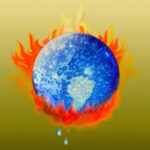It is now common knowledge that global warming is becoming a significant issue that humanity needs to confront as soon as possible. We should not address global warming from the standpoint of politics or economics, but rather for the survival of humanity. For those who still do not think that humans are not contributing to the climate change, think again. The Intergovernmental Panel on Climate Change (IPCC) says that there is a 90 percent chance that humans are the ones contributing to global warming. Internationally, scientists have claimed that the global average temperature could increase by as much as 2 to 11 degrees Fahrenheit by the year 2100, and that the sea level could rise up to 2 feet. Two degrees Fahrenheit may not seem like much, but the connotations from his number are dire, as it means diseases that previously could not survive in temperatures lower than that number, now has hundreds of miles by which to spread.
The catastrophe that scientists have predicted is a dire warning to society to get their act together. With a slight increase in Earth’s rotation, disappearing glaciers, epic floods, intense droughts, widespread water shortages, famine, disease, mass extinction of plants and animals, as well as a changing landscape, are all obvious reasons to bring our efforts to saving Mother Earth. Nobody can really know what lies in the future, but according to recent events, these predictions paint a general idea of what Earth’s future holds.
2007
The world population is now calculated to be at a staggering 6.6 billion people, many people now live in major cities all over the world. This changes the land through different usages. (Peter Crane, Royal Botanic Gardens, UK, Science; UN World Urbanization Prospectus: The 2003 Revision; U.S. Census Bureau)
2008
The global oil crisis becomes a calamitous issue, as experts pinpoint oil production peak during the years 2008 to 2018. This turning point, called “Hubbert’s Peak” will trigger an irreversible decline in oil production, and perhaps generate other more serious issues such as global recession, food shortages, and wars between countries in need of oil. (Frederik Robelius, University of Uppsala, Sweden; report by Robert Hirsch of the Science Applications International Corporation)
2020
According to IPCC, the chance of flash floods occurring in all parts of Europe will increase dramatically. While floods are occurring in Europe, intense droughts in other parts of the world will mean a shortage of food by up to 50 percent.
By this time, the world population has reached 7.6 billion people. (U.S. Census Bureau)
2030
Diseases that cause diarrhea will increase by up to 5 percent in impoverished regions of the world. (IPCC)
Climate change and other environmental issues have already begun taking their toll on Mother Earth, as up to 18 percent of the world’s coral reefs will be extinct. Coral loss in other parts of the world such as Asia could reach as much as 30 percent. (IPCC)
World population will reach 8.3 billion people. (U.S. Census Bureau)
In Africa, global warming will cause glaciers on mountains near the equator to disappear. (Richard Taylor, University College London, Geophysical Research Letters🙂
In developing countries such as China and India, an urban popuation explosion will put the number of people at 4 billion per the city’s given space. The urban population in devloped countries will increase even more by as much as 20 percent. (World Bank: The Dynamics of Global Urban Expansion)
2040
The Arctic Sea, usually packed with ice, will now be ice free in the summer, and the depth of ice during the winter may shrink drastically. This is up for debate though, as other scientists predict that the region will still have summer ice up to 2060 and 2105. (Marika Holland, NCAR, Geophysical Research Letters)
2050
Small glaciers will disappear completely, and the large glaciers will shrink by about 30 to 70 percent. Austrian scientist Roland Psenner of the University of Innsbruck says this is a conservative estimate, and the small alpine glaciers could be gone as soon as 2037. (IPCC)
Temperature-related deaths will become a prominent issue at this time, as in different parts of the world, people will be dying from extreme heat and cold. It is predicted that 3,200 to 5,200 heat-related deaths will occur in Australia and 500 to 1,000 deaths in New York City. In the United Kingdom, just the opposite will occur as cold-related deaths will increase faster than heat-related deaths. (IPCC)
World population by now reaches for the 10 billion mark as population reaches 9.4 billion people. (U.S. Census Bureau)
Crop shifts will make agriculture very difficult, as in East and Southeast Asia, crop yields will increase by up to 20 percent, while decreasing in their counterpart regions of Central and South Asia. The same crop shift yields may occur on other continents, not only Asia. (IPCC)
During 2050, animals and plants could be starting to face extinction from the face of the Earth. (Jay Malcolm, University of Toronto, Conservation Biology)
2070
The melting of the glaciers and the intense drought ensuing in other regions will decrease hydropower potential by up to 50 percent. The dry conditions will undoubtedly result in more frequent and longer droughts, longer fire seasons, increased fire risks, and more heat waves. The hardest hit area will be regions in the Mediterranean. (IPCC)
2080
The extreme shifts in climate will be occurring all over the world by the year 2080. While some parts of the world are trapped in extreme droughts, other regions will be swamped with water. Scientists predict that nearly 20 percent of the world’s population will be affected by rising flood hazards. The 20 percent account for about 100 million people that could experience coastal flooding each year. People that live in densely populated, low-lying areas will be in hazardous zones because of their inability to adapt to rising sea levels, as well as other conflicts such as tropical storms. (IPCC)
With that in mind, coastal population could reach up to 5 billion, a drastic increase in the number of people as compared to the 1.2 billion living near coastal waters in 1990. IPCC)
600 million people will be in a state of starvation and 1.1 to 3.2 billion people will be experiencing water shortages. (IPCC)
New York City could be flooded by more than three feet of sea water, potentially devastating the areas of Rockaways, Coney Island, Southern Brooklyn and Queens, sections of Long Island City, Astoria, Flusing Meadows-Corona Park, Queens, lower Manhattan and eastern Staten Island from Great Kills Harbor north to the Verrazano-Narrows Bridge. (NASA GISS)
2085
As a result of climate change, dengue fever is expected to affect up to 3.5 billion people. (IPCC)
2100
Under the extreme circumstances of global warming and other factors, ecosystems will be pushed beyond their natural ability to adapt to climate change. (IPCC)
The CO2 in the atmosphere will be radically higher than any single given time during the past 650,000 years. (IPCC)
Scientists predict that the ocean pH levels could decrease by as much as 0.5 pH units, the lowest it’s ever been in the last 20 million years. Marine life could be harmed through this drop in pH levels as it could impair their ability to create shells and exoskeletons. (IPCC)
The permafrost at many parts of the world covers tons of carbon dioxide that has been frozen in the ground. With the thawing permafrost, Earth will be emitting more carbon dioxide into the air than it absorbs. (IPCC)
By the year 2100, 20 to 30 percent of the species in the world could be extinct if global temperatures rise more than 2 to 3 degrees of pre-industrial levels. (IPCC)
With this change, new climate zones that we have never seen before could begin to cover 39 percent of the world’s land. (Jack Williams, University of Wisconsin-Madison, Proceedings of the National Academy of Sciences)
A quarter of the world’s organism, account for more than a million species total, could be facing certain extinction. According to IPCC, “we are currently unprepared for climate change and responses to the adaptation could be costly.” (IPCC)
The notorious “Dust Bowl” drought of the 1930s that occurred in the United States could be seen elsewhere, from the American Southwest, to northern Mexico, and even the eastern side of the world including Europe, Africa, and the Middle East. (Richard Seager, Lamont Doherty Earth Observatory, Science)
2200
In two centuries, the Earth itself will be affected, not just the ecosystems and the species living in it. Rising temperatures over parts of the world could cause oceans to expand towards the poles, and could shorten the time of the day by 0.12 milliseconds. As the oceans move towards the pole, the axis of rotation could be affected. Having more mass near the poles should cause the planet to rotate faster. (Felix Landerer, Max Planck Institute for Meteorology, Geophysical Research Letters)
Although this timeline appears as a pessimistic warning to society, there is still time to change. Even though we as people have triggered an irreversible action, we still have hundreds of years to help each other decrease the effects of global warming. Even the most miniscule of actions such as walking to your neighbor’s house three blocks away instead of driving, will help the world in the long run. So take a little time to think about your everyday actions, and if that means sacrificing a little something to gain a better future, it’s worth it. And even if most of you have the mindset that in a hundred years, nothing will matter because you’re dead, you’re helping your children and society make a run for a better future.
Andrea Thompson and Ker Than. “Timeline: The Frightening Future of Earth.” Live Science. http://www.livescience.com/environment/070419_earth_timeline.html






